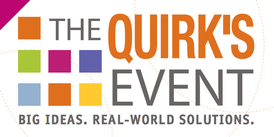|
In college, I took a course called "Finance for Non-Finance Majors" (I think the department head lost out on his preferred "Finance for Dummies" title). It's a good principle though--we aren't all going to be accountants or marketers or designers, but it can be useful as a small business owner, solopreneur, or anyone who collaborates with these functions to have a working knowledge of some of the principles and tools of other disciplines. For me, working in consumer research and insights, graphic design is a key complementary discipline. I firmly believe that market research needs great graphic design like a cupcake needs frosting. Great design pulls in your audience, helps you clearly communicate the story and makes the content more engaging. To that end, I often do work with professional graphic designers to help take my decks and reports to the next level. But I don’t always have the time or the budget to do that or frankly, sometimes I just need a deliverable that’s “good enough”. Over the years as an independent insights consultant, I’ve discovered a handful of resources that can make marketing my own business and creating proposals and reports for others more beautiful, more interesting and just overall, more professional-looking.  Icons Something I’ve picked up from working with actual designers is that a few, well-placed icons in a consistent style and color palette can really add that final level of polish to a report or other deliverable. I use The Noun Project and find it valuable enough to have actually ponied up for a paid subscription (very reasonable at $40/year currently). Sometimes icons are purely decorative, but they can work harder too. For example, if you use specific icons consistently throughout a report to represent particular consumer groups, those icons can stand in for text in complicated chart or graphics to make them easily readable.  Stock photography There is a lot of terrible stock photography out there. To avoid it, you basically have two choices. One, you can pay for a subscription to a high-quality stock image service like Adobe Stock or Shutterstock. That may be a good option if you need lots of images for commercial use, but it’s not cheap. Alternately, if you just need images occasionally and they don’t have to be super-specific, there are a few great, free stock photo sources. Two that I frequently use are: Unsplash, which has a beautiful, searchable website, and Death to Stock which sends free unique photos out in themed packs via email. Be sure to credit the creators appropriately (each site has their own guidelines).  Fonts Here’s what I know about special fonts: not using them can make materials look generic, but using them inappropriately makes you look like a complete idiot. I prefer to risk erring on the generic side, especially since I’m typically dealing with client-facing deliverables (vs. creative marketing output). That said, if you’re feeling brave, you can find lots of free and unique fonts on Dafont. Just remember that if you’re using a non-standard font, there’s a good chance it won’t look the same on someone else’s computer in a document (unless they have also downloaded the same font). When it doubt, send the document as a PDF to preserve fonts.  Infographics Here’s an area I would love to grow my own design expertise—creating infographics! There’s a reason information presented in this format gets shared so much online—if done right, it’s a fun and engaging way to communicate data. If I decide I simply must create my own infographic, the best option I’ve found is Venngage. They have a basic selection of free infographic templates that you can play around with online to create a custom version. If you love it, there are also paid subscriptions that give access to all the premium templates as well ($19/month for an individual). If you’re interested in data visualization more broadly, I also suggest you check out Viz-Fest, which is a (free) webinar series on the topic.  Photo editing If you are working with stock photography (or your own), you’ll likely need photo editing software at some point. If you don’t have the need level or expertise for an Adobe Creative Cloud subscription (e.g. Adobe Illustrator, Adobe Photoshop, etc.), you can stay in the Adobe family with Photoshop Elements (one-time purchase), which is a more basic and user-friendly version of Photoshop. There are a few good, free online photo editing sites as well. I recommend Fotor or Pixlr (the latter also has links on its homepage to free vector editor, fonts, and graphics sites). One of my most common image editing needs is just to reduce the file size of an image, particularly for use in email. The interface could use a little design help itself, but this free Image Optimizer site has always done the trick for me. If you work in market research (or marketing or any related disciplines), I highly recommend that you find an awesome freelance graphic designer or design firm to partner with, if you don’t work for a company with those resources in-house. Working with designers and seeing their creations is probably the best way to build your own eye for design. And for everything else, I hope these design tools and resources can help fill the gaps!
0 Comments
 I recently attended the inaugural West Coast Quirk’s Event in Irvine, California, a market research industry conference focused on “big ideas, real-world solutions”. Looking back, the unofficial theme of the presentations I saw seemed to be: let’s get closer! This played out in multiple ways: get closer to reality with new ways of collecting data, including in-the-moment research, get closer to consumers/customers with co-creation and empathy in research, and finally, get closer to seeing the whole picture with mixed methods and data integration. Here are a few more specifics and examples from the conference to bring these themes to life. In-the-moment research ensures authenticity in data collection
Co-creation and shared experiences compress timelines and foster empathy
Mixed methods and data integration provide holistic insights
 We’ve probably all seen examples of awful questionnaires or discussion guides. If you want more, there are plenty online—check out @MRXshame on Twitter for some hilarious ones. The crux of the issue is that we, as market researchers—client or supply side—have all been guilty of designing surveys that we would never want to complete ourselves. We conveniently forget or ignore how tedious those grid questions are, how annoying it is to answer the same question worded slightly differently multiple times, how impossible it is to remember something you bought six months ago, and how your attention span starts to wane after 10 or 15 minutes. There are significant consequences of bad questionnaire writing, in the form of bad data and unreliable results—from straight-lining or random responses from the people who do finish your survey to chronically under-representing certain groups from people who drop out. For example, Quirk’s published a compelling study in February 2016 (“The impact of survey duration on completion rates among Millennial respondents”) which found that there’s a major drop-out inflection point among Millennial respondents after 15 minutes. Education and training are critical to master good research design and quality, but even if we have a good foundation, we can still lose touch with the people who respond to and participate in our research. To that end, I want to offer a few simple suggestions that we can all start applying today to help us create research we would actually want to participate in ourselves. 1. Be someone else’s respondent. Sign up for some online quantitative research panels or apps (e.g. e-Rewards, Field Agent, SurveyMini, The Pryz Manor, etc.) as a respondent. Always be honest—if they’re screening out market researchers, you can’t participate. But for the ones you can complete, you’ll get great ideas for what works, what to avoid, and how to make survey research more engaging. Nothing builds respondent empathy faster than taking a poorly-designed survey! I would not recommend signing up for qualitative panels though. They should all have industry screen-outs and even if they don’t, the chance of messing up someone’s research in a qualitative setting with small base sizes is just too high. 2. Eat your own cooking. Take your own survey. No, you might not be the target consumer, but you are a human. If filling out that complex matrix question drives you nuts—and you wrote it!—imagine how someone who doesn’t care nearly as much about your category/business will feel. Look with alien eyes at that creative exercise you planned. Are the instructions clear? If you didn’t know what you know about your product/brand/category, would it make sense to you? How long will it really take to find all those images or complete that storytelling exercise? 3. Phone a friend. Request peer-reviews of your questionnaires and discussion guides. If you’re on the client side, exchange surveys with colleagues for feedback, especially those outside your business unit/category if possible. On the supply side, you can also get feedback from co-workers, but just be mindful of confidentiality if you go outside the client team (i.e. use an in-market ad or package instead of the test one as stimuli, remove any proprietary client questions, etc.) If you’re an independent consultant or don’t have ready access to colleagues for any other reason, strike a deal with a few trusted professional contacts to do a “feedback exchange” for questionnaires, guides, etc. where you review each other’s’ materials on a regular basis. The confidentiality caution applies here too. 4. Straight from the horse’s mouth. There’s probably no better way to understand the real survey-taking experience than pre-testing it with consumers (i.e. not professional researchers.) There’s a range of ways to approach this—from very quick and informal all the way to an additional phase of research, depending on existing knowledge, business risk, and budget. The most informal way to do this is to find people who fit the most basic criteria (e.g. pet-owners, restaurant-goers, detergent-buyers, vacation-planners, etc.) in your workplace or among friends and family and go through your screener, questionnaire or discussion guide with them. In this context, I think it’s most effective to administer it like a face to face interview where you read the questions out loud and mark their answers. You’ll get some instant feedback as you go (e.g. facial expressions, questions about the questions, etc.) and you can also ask for direct feedback too. On the other end of the spectrum, if you’re planning a large-scale research project (multiple legs or geographies, a very high investment, or large potential business impact), doing a small qualitative phase up front to develop the questionnaire or guide can pay huge dividends. This also applies if you’re going to be researching a category/industry that’s relatively new to you and you don’t necessarily know all the right consumer language, response options, category attributes, etc. -- Whether you’re learning to think like a respondent by actually being one, or getting feedback from a professional researcher or lay-person, we can all use these insights to make our research better—a little clearer, less complex, more engaging, and ultimately, higher quality. |
AuthorSarah Faulkner, Owner Faulkner Insights Archives
July 2021
Categories
All
|

 RSS Feed
RSS Feed
